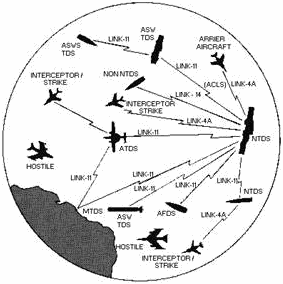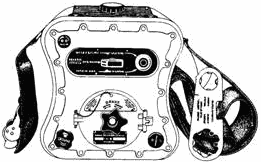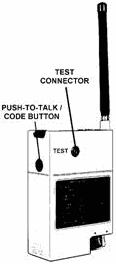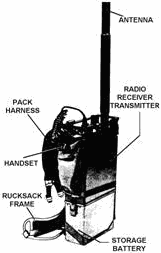| - |
Matter, Energy,
and Direct Current |
| - |
Alternating Current and Transformers |
| - |
Circuit Protection, Control, and Measurement |
| - |
Electrical Conductors, Wiring Techniques,
and Schematic Reading |
| - |
Generators and Motors |
| - |
Electronic Emission, Tubes, and Power Supplies |
| - |
Solid-State Devices and Power Supplies |
| - |
Amplifiers |
| - |
Wave-Generation and Wave-Shaping Circuits |
| - |
Wave Propagation, Transmission Lines, and
Antennas |
| - |
Microwave Principles |
| - |
Modulation Principles |
| - |
Introduction to Number Systems and Logic Circuits |
| - |
- Introduction to Microelectronics |
| - |
Principles of Synchros, Servos, and Gyros |
| - |
Introduction to Test Equipment |
| - |
Radio-Frequency Communications Principles |
| - |
Radar Principles |
| - |
The Technician's Handbook, Master Glossary |
| - |
Test Methods and Practices |
| - |
Introduction to Digital Computers |
| - |
Magnetic Recording |
| - |
Introduction to Fiber Optics |
| Note: Navy Electricity and Electronics Training
Series (NEETS) content is U.S. Navy property in the public domain. |
NEETS Module 17 - Radio-Frequency Communications Principles
Pages i,
1-1,
1-11,
2-1,
2-11,
2-21,
2-31,
3-1,
3-11,
3-21,
3-31,
3-41,
4-1- to 4-10,
4-11,
5-1,
5-11, Index
automation, the NTDS provides commanders with a broad picture of the current
tactical situation. It also assists them in directing their operations in time to
intercept and destroy all potential enemy threats. The use of digital computers
and digital data processing techniques reduces reaction time and increases force
effectiveness.
NTDS uses a variety of equipment. This equipment includes transmitters, receivers,
cryptographic equipment, high-speed digital computers, magnetic tapes, disks, and
a variety of displays. Figure 5-10 shows the NTDS equipment grouping and how it
interfaces with the weapons and sensor systems of a ship. Figure 5-11 shows the
NTDS system inputs and outputs. As you can see, large amounts and various types
of information are provided to or taken from the NTDS. Now that you have seen the
types of information associated with the NTDS, let's look at how this information
is transmitted and used.

Figure 5-10. - NTDS equipment grouping.

Figure 5-11. - NTDS system inputs/outputs.
NTDS Data Transmission Subsystems
NTDS uses three separate data transmission links to maintain tactical data communications
between tactical units. Figure 5-12 illustrates these links. Each link is able to
transfer data rapidly to other ships, aircraft, and shore facilities without the
delay of human interface (link 14 receive is an exception to this). The data processing
subsystem formats the messages for each of the data links. These messages are based
on shipboard inputs (from displays, sensors, and other data links).

Figure 5-12. - NTDS communications links.
The automatic data communications links provide the operational commander with
a high-speed, accurate mode of tactical communications. Link 11 provides high-speed,
computer-to-computer transfer of tactical information, command orders, and unit
status to all tactical data systems. View a shows you this configuration. The type
of tactical information currently transferred is surface, subsurface, air, and EW
track information. Data is provided on friendly, hostile, and unknown identity tracks.
This broadcast originates through console button actions by the console operators.
Link 14 provides a means of transmitting track information to those units not
capable of participating in the link 11 network. View B shows this network. This
is a one-way broadcast of information.
Link 4A permits the computer to take control of the autopilot in an equipped
aircraft. Also this link can control a plane under other situations. It may control
a flight out to a strike area and return it to base without the need for pilot action.
The pilot also has the option of overriding the link. The pilot may use the visual
display to aid in understanding the intercept controller, or to totally ignore the
link 4A
5-12
transmission. View C shows this link used in conjunction with the automatic carrier
landing system
(ACLS).
Figure 5-13 is a drawing of an intersystem communications employment diagram.
It shows the overall possibilities and flexibility of the NTDS. The new terms shown
are defined below:

Figure 5-13. - Intersystem communications employment.
· MTDS-Marine tactical data system
· AFDS-Amphibious flagship data system
· ATDS-Airborne tactical data system
· ASWTDS-Antisubmarine warfare tactical data system
Now that we've looked at a complex and stationary system, let's study some fundamental
portable equipment.
Q7. What is the primary advantage of NTDS over conventional systems?
Q8. What are the three NTDS data transmission subsystems?
5-13
PORTABLE Equipment
Portable and pack radio sets must be lightweight, compact, and self-contained.
Usually, these sets are powered by a battery or a hand generator, have low output
power, and are either transceivers or transmitter-receivers. a transceiver consists
of a transmitter and a receiver that share common circuits and are housed in the
same case or cabinet. a transmitter-receiver is the combination of two separate
pieces of equipment that are used together. Navy ships carry a variety of these
radio sets for emergency and amphibious communications. The numbers and types of
equipment vary according to the individual ship.
Emergency Equipment
One piece of emergency equipment is shown in figure 5-14. It is a rugged emergency
transmitter carried aboard ships and aircraft for use in lifeboats and life rafts.
The transmitter operates on the international distress frequency (500 kilohertz)
and the survival craft communications frequency (8,364 kilohertz).

Figure 5-14. - Typical emergency lifeboat transmitter.
The complete radio transmitter, including the power supply, is contained in an
aluminum cabinet that is airtight and waterproof. The cabinet is shaped to fit between
the legs of the operator and has a strap for securing it in the operating position.
The only operating controls are a three-position selector switch and a push-button
telegraph key. a hand crank screws into a socket in the top of the cabinet. The
generator, automatic keying, and automatic frequency changing are all operated by
turning the hand crank. While the hand crank is being turned, the set automatically
transmits the distress signal SOS in Morse code. The code consists of six groups
of SOS followed by a 20-second dash. It is transmitted alternately on 500 kilohertz
and 8,364 kilohertz. The frequency automatically changes every 50 seconds. These
signals are intended for reception by two groups of stations, each having distinct
rescue functions. Direction-finding stations cooperating in long- range rescue operations
normally use 8,364 kilohertz, whereas aircraft or ships locally engaged in search
and rescue missions use 500 kilohertz.
Besides the automatic feature, you can key the transmitter manually on 500 kilohertz
only. This is done by means of a push-button telegraph key.
5-14
Additional items (not shown) packaged with the transmitter include the antenna,
a box kite, and balloons for supporting the antenna. Hydrogen-generating chemicals
for inflating the balloon and a signal lamp that can be powered by the hand-crank
generator are also included.
The equipment floats and is painted brilliant orange-yellow to provide good visibility
against dark backgrounds.
A transceiver is shown in figure 5-15. It is portable, battery powered, and has
two channels. It provides homing information and two-way voice communications between
life rafts and searching ships and aircraft. This transceiver is a microminiature,
solid-state, hand-held radio that operates on the 121.5-megahertz and the 243-megahertz
guard channels. The transceiver has four operating controls. These are the volume
(VOL) control, the two-position Frequency Selector, the Push-to-Talk / Code button,
and the three-position Mode switch.

Figure 5-15. - Emergency portable transceiver.
The antenna is a rubber covered, omnidirectional, flexible whip antenna that
is 7.74 inches long. The batteries supplied with the radio set are lithium D cells.
Each cell is fused to protect against damage from external short circuits. Two cells
are installed in the transceiver and four are packaged as spares.
Operational Equipment
An operational transceiver is shown in figure 5-16. It is watertight, lightweight,
portable, and operates in the vhf and uhf range. You can use any of 1,750 channels,
spaced 200 kilohertz apart, in the 225-400 megahertz range. Its mode of operation
is AM voice and it supplies an average output power of 3 watts. It was designed
mainly for manpack (backpack) use, but it may also be used at a fixed station or
in vehicles when certain accessories are added. When not in use, the equipment is
disassembled and stowed in a special aluminum case similar to an ordinary suitcase.
5-15

Figure 5-16. - Typical vhf/uhf backpack transceiver.
Figure 5-17 shows a typical vhf miniaturized manpack radio set. View a shows
the pack frame, the handset, and the canvas accessory pouch. The pouch contains
two antennas (one flexible steel band-type whip and one collapsible rigid whip).
The handset fits in the pouch when not in use. View B shows the transmitter-receiver.

Figure 5-17. - Vhf receiver-transmitter.
5-16
Now that you have learned about portable equipment, let's look at one of the
newest areas of communications. You are going to learn the fundamentals of how a
laser works and how it may be used in the field of communications.
Q9. What are the three main design considerations of portable equipment?
Lasers
The word Laser is an acronym for light amplification by stimulated emission of
radiation. The laser is widely used in industry, and experimental work is being
done with it in communications. You will find a laser is similar to uhf and microwave
power sources and could replace either of them in point-to-
point communications.
THEORY of Operation
Lasers take energy at (or near) the visible light spectrum and convert it to
a very narrow and intense beam in the same region. a close relative of the laser
is the light emitting diode (LED). The LED takes dc or low frequency ac power and
converts the energy into visible light.
The principle of the laser is somewhat similar to that of a very high-Q cavity
resonator. Chapter 1 of NEETS, Module 11, Microwave Principles, explains cavity
resonators. The laser is shock-excited by a spark transmitter. This transmitter
is called a spark transmitter because it uses the discharge of a capacitor through
an inductor and a spark gap as a source of rf. While the input energy of the laser
covers a wide band of frequencies, the output is on one frequency. Energy outputs
of the laser are either Incoherent or Coherent. For example, if you turn on a transmitter
with no modulation, you will get coherent radiation. When you connect a noise source
to an antenna, the result is incoherent radiation.
Lasers can be either CW or pulsed. Actually, lasers are little different from
conventional oscillators. However, the way lasers convert energy from one form to
another is quite different. In conventional oscillators, dc power from the collector
is converted to RF energy. The frequency is for the most part independent of the
molecular or atomic structure of the generator. This is not true for the laser.
Laser conversion takes place directly within the molecular structure of a crystal
or gas. The external circuits have little effect on actual output frequency. The
fact that the light from an LED is always the same color results from similar conditions.
In a laser, incoherent light excites the electrons in the atoms to higher energy
levels than they normally would have. The new energy states are unstable and the
electrons drop down to lower energy levels. Energy is then released in the form
of light.
Figure 5-18 shows the ends of the crystal or glass tube laser with light waves
reflecting back and forth between two mirrored surfaces. One mirror is only partially
reflective, and light energy is transmitted through it to form the light beam. You
will find that power sources for lasers include flash tubes or, in the case of diode-type
lasers, dc power supplies.
5-17

Figure 5-18. - Simple laser.
Communications Applications
High-energy lasers have very small power losses. As a result, a laser with a
2- or 3-inch initial beam can be used to communicate directly with a distant planet.
However, from a communications standpoint, they do have some drawbacks. While laser
energy is capable of being formed into a very narrow beam, it is still subject to
the same difficulties as any other form of light transmission. Fog and other adverse
weather conditions can absorb the light. Small atmospheric temperature variations
can cause deflection and scattering. An optical waveguide was designed to help overcome
this problem. It consists of a thin dielectric fiber clothed by another dielectric
coating several wavelengths thick. It has been successfully used to move the beam
over considerable distances and around bends. The use of optical waveguides is known
as Fiber Optics. a number of fibers can be paralleled to reduce the attenuation
through the waveguide. This technique has resulted in an inexpensive telephone system
with a bandwidth greater than that of previous methods. Researchers are attempting
to develop a laser that will operate in the blue-green portion of the visible spectrum.
Water offers little attenuation to the blue-green band of frequencies. Because of
this, blue-green communications lasers could possibly penetrate the ocean to great
depths.
This could give us a very secure undersea communications link.
Q10. Lasers operate in what portion of the frequency spectrum?
Q11. What are the two types of lasers?
Q12. What are the effects of adverse weather on the laser beam?
5-18
Summary
Now that you have completed this chapter, a review of what you have learned is
in order. The following summary will refresh your memory of new terms.
Doubling Up is a type of two-equipment installation where one
unit can be substituted for another in the event of failure.
Frequency Synthesizer is a frequency source of high accuracy.
Dummy Load is a nonradiating device that absorbs the RF and
has the impedance characteristics of the antenna.
Helix House is a building at a transmitter site that contains
antenna loading, coupling, and tuning circuits.
A Helix is a large coil of wire. It acts as a coil and is used
with variable inductors for impedance matching of high-power transmitters.
TOP-HAT antennas are center-fed and capacitively loaded.
TRIATIC is a special type of monopole antenna array.
Laser is an acronym for light amplification by stimulated emission
of radiation.
Coherent refers to radiation on one frequency or nearly so.
Incoherent refers to radiation on a broad band of frequencies.
Fiber Optics are conductors or optical waveguides that readily
pass light.
MTDS is an abbreviation for the marine tactical data system.
AFDS is an abbreviation for the amphibious flagship data system.
ATDS is an abbreviation for the airborne tactical data system.
ASWTDS is an abbreviation for the antisubmarine warfare tactical
data system.
5-19
Answers to Questions Q1. Through Q12.
A1. An impedance-matched device capable of absorbing all of a transmitters
power.
A2. It demodulates SSB, CW, and FSK signals.
A3. 300 kilohertz to 3 megahertz.
A4. Troposphere.
A5. Up to 600 4-kilohertz channels.
A6. Up to 800 kilometers (500 statute miles).
A7. Speed.
A8. Links 4A, 11, and 14.
A9. They must be lightweight, compact, and self-contained.
A10. At or near visible light.
A11. CW or pulsed.
A12. It absorbs it.
5-20
|

















